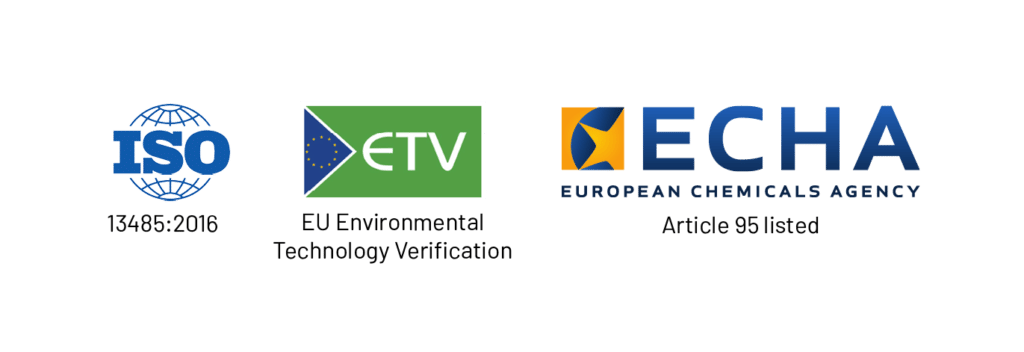
The BacTerminator® disinfection system gives a Log 2 to Log 7 reduction.
All tests were analysed and verified by an externally accredited laboratory (Eurofins).
BacTerminator® has been tested on following microorganisms:
Broad spectrum antimicrobial effect. Active chlorine generated in-situ in aqueous solution referred to as “electrochemically activated solutions (ECAS)” have been shown to have broad-spectrum antimicrobial activity. Numerous studies have found ECAS to be efficacious against gram positive bacteria like Staphylococcus spp, Listeria monocytogenes, sporeforming Bacillus spp., Clostridium difficile and gram negative bacteria like Legionella pneumophila, Pseudomonas aeruginosa, Enterococcus spp., Escherichia coli, Campylobacter jejuni, the fungus Aspergillus spp. and the yeast Candida spp.
Mode of action. Solutions with active chlorine characteristically have an ORP of +800 mV to +1,200 mV, creating an environment outside the working range of important microbial processes, including energy-generating mechanisms. If immersed in these solutions, microorganisms will be exposed to powerful oxidants which will sequester electrons with high efficiency from microbial structural compounds, causing the rupturing of biochemical bonds and subsequent loss of function. Moreover, the high ORP environment creates an unbalanced osmolarity between the ion concentrations in the solution and that within unicellular organisms, further damaging membrane structures. This causes increased membrane porosity, enabling oxidising moieties (present in excess in active chlorine solutions) to penetrate (via diffusion) into the cell cytoplasm, ultimately leading to the inactivation of intracellular protein, lipids and nucleic acids, rendering the cell non-functional.
Test results of representative biocidal products. Test solutions of active chlorine have been tested for their bactericidal, sporicidal, fungicidal and virucidal efficacy. The tests are either according to EN standards or national standards for testing efficacy of disinfectants. The tests have been performed on human skin, on non-porous surfaces and in aqueous suspensions in order to cover the full range of product types 1-5 defined in the BPR. The tests performed are phase 1 or phase 2 types of tests. No field trials (phase 3 tests) have been performed. The golden standard so far accepted by European authorities is that disinfectants have to pass either phase 1 suspension tests or phase 2 semi-field tests. The results are presented in the following.
1.1 Efficacy against bacteria on skin. EN 1499 Chemical disinfectants and antiseptics: Hygienic handwash – Test methods and requirements: The test solution with active chlorine showed significantly more bactericidal activity than the positive control and more than log 4 reduction after 1 min. The test solution passed the efficacy criteria for hygienic handwashing products.
EN 1500 Chemical disinfectants and antiseptics: Hygienic handrub – Test methods and requirements: The test solution with active chlorine showed equally bactericidal activity as the positive control and more than log 4 reduction after 1 min. It passed the efficacy criteria for hygienic handrub products.
1.2 Efficacy against bacteria, fungi and yeast on non-porous surfaces. EN 13697 Chemical disinfectants and antiseptics – quantitative surface test for the evaluation of bactericidal and/or fungicidal activity of chemical disinfectants used in food, industrial, domestic and institutional areas (Phase 2, Step 2): The test solution with active chlorine achieved a 4 log reduction in viable counts for bacteria under the required test conditions with a minimum exposure time of 5 min. The test solution with active chlorine sufficiently inactivated the fungi Aspergillus brasiliensis with a log reduction >3, under clean conditions after 15 minutes exposure. For the yeast Candida albicans a 3 log reduction in viable counts under the required test conditions was achieved with after a contact time of 15 min.
1.3 Efficacy against sporeforming bacteria in suspension. The sporicidal effect test, quantitative suspension trial with Bacillus subtilis according to VLB-method was performed. The test solution with active chlorine achieved a reduction of Bacillus subtilis-spores. The reduction was between log 2.7 and log 3.5.
1.4 Efficacy against bacteria in suspension. EN 1656 Chemical disinfectants and antiseptics – Quantitative suspension test for the evaluation of bactericidal activity of chemical disinfectants and antiseptics for use in the veterinary field – Test method and requirements (Phase 2, Step 1) was performed. The test solution with active chlorine showed bactericidal activity under organic load of 1% skimmed milk after 5 minutes exposure time.
EN 13623 Chemical disinfectants and antiseptics. Quantitative suspension test for the evaluation of bactericidal activity against Legionella of chemical disinfectants for aqueous systems- Test method and requirements (phase 2, step 1) was performed. The test solution with active chlorine showed bactericidal activity with 0.0005% yeast extract under conditions for hard water for general purposes after 60 min. exposure.
1.5 Efficacy tests against enveloped and non-enveloped virus EN 14476 + German guideline was performed. Test solutions with active chlorine effectively inactivated adenovirus and murine norovirus after 1 min under clean and dirty conditions, poliovirus after 1 min under clean conditions and after 30 min. under dirty conditions. The solution also effectively inactivated vaccinia virus after 1 min. and bovine viral diarrhea virus after 5 min. exposure.
If you have any questions or need other help,
please feel free to contact us
